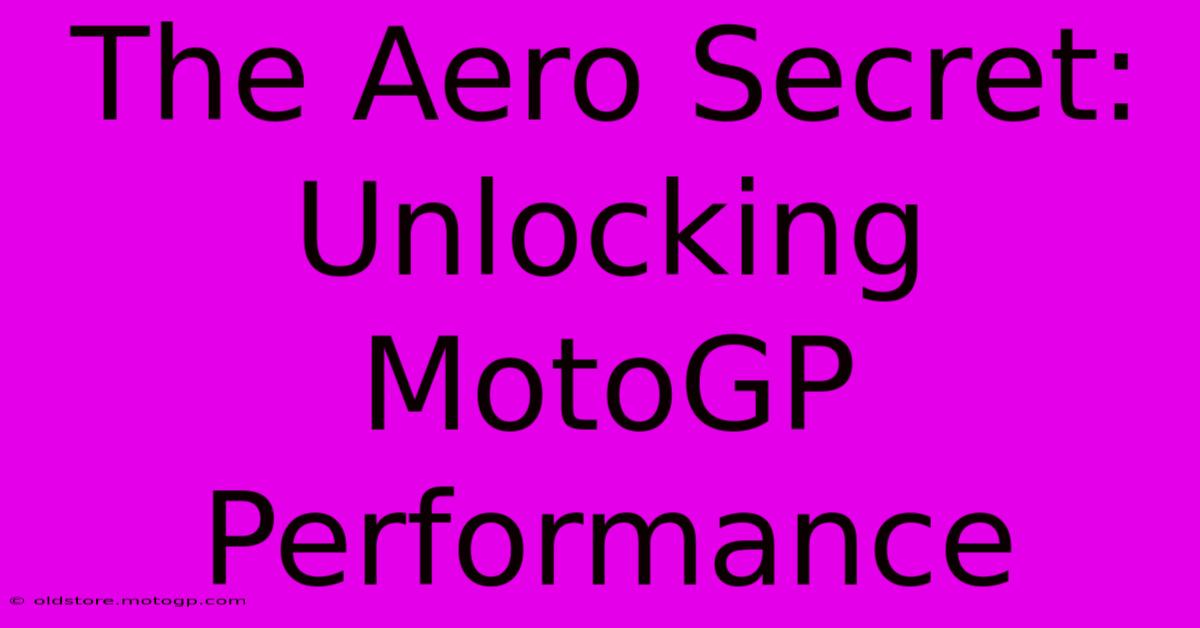The Aero Secret: Unlocking MotoGP Performance

Table of Contents
The Aero Secret: Unlocking MotoGP Performance
MotoGP. The pinnacle of motorcycle racing. Speeds exceeding 200 mph, breathtaking overtakes, and riders pushing the limits of human endurance. But behind the spectacle of screaming engines and daring maneuvers lies a crucial, often-overlooked element: aerodynamics. This article delves into the "aero secret" – the sophisticated science and engineering behind the aerodynamic performance that separates winning teams from the also-rans.
The Importance of Aerodynamics in MotoGP
Aerodynamics in MotoGP isn't just about speed; it's about control, stability, and ultimately, lap times. At these incredible velocities, even minor aerodynamic inefficiencies can dramatically impact performance. Think of it this way: every gram of drag reduced translates to precious milliseconds gained on the track.
Drag Reduction: The Pursuit of Speed
The primary goal of MotoGP aerodynamics is drag reduction. Less drag means higher top speeds on straights and more efficient acceleration out of corners. Teams achieve this through:
- Streamlined Fairings: The motorcycle's bodywork is meticulously designed to minimize air resistance. Every curve and angle is carefully considered using Computational Fluid Dynamics (CFD) simulations.
- Winglets and Aerodynamic Appendages: These small wings and appendages generate downforce, but also impact drag. The design needs to be optimized for a balance of downforce and minimal drag penalty. The evolution of these wings is a fascinating study in itself!
- Rider Position: Even the rider's posture plays a role in minimizing drag. A tucked-in position reduces the frontal area presented to the airflow.
Downforce: Cornering Mastery
While minimizing drag is crucial for top speed, downforce is paramount for cornering. Downforce presses the motorcycle to the track, improving grip and allowing riders to carry higher speeds through bends. This is especially critical on fast, sweeping corners where maintaining stability is vital. Sources of downforce include:
- Winglets: As mentioned earlier, winglets are strategically positioned to generate downforce, particularly at the front and rear of the bike.
- Underbody Aerodynamics: The design of the underbody plays a critical role in generating ground effect, enhancing downforce.
- Fairing Design: The shape of the fairing itself contributes to generating downforce by manipulating airflow.
The Constant Evolution of MotoGP Aerodynamics
MotoGP aerodynamics is a constantly evolving field. Teams are in a perpetual arms race, constantly refining their designs to gain even the smallest advantage. New materials, innovative designs, and advanced simulation techniques are continuously being developed and implemented. This relentless pursuit of aerodynamic perfection is a major reason why MotoGP bikes are so visually striking and technologically advanced.
The Role of Technology and Innovation
Computational Fluid Dynamics (CFD) plays a massive role in modern MotoGP aerodynamics. CFD simulations allow engineers to virtually test different designs before physically creating them, saving time and resources. Wind tunnel testing remains crucial, but CFD complements it by offering faster and more flexible design exploration.
The Human Factor
It's not just about the technology; the rider's skill and feedback are invaluable. Riders provide crucial data on how the bike feels at different speeds and cornering angles, helping engineers to fine-tune the aerodynamic design. The perfect aerodynamic setup is useless without a skilled rider to exploit it.
The Future of Aero in MotoGP
The future of MotoGP aerodynamics promises to be even more sophisticated. We can expect to see further refinements in existing technologies, as well as the introduction of entirely new concepts. The quest for marginal gains continues, pushing the boundaries of what's possible in motorcycle racing. The "aero secret" remains a constant source of innovation and excitement in the world of MotoGP.
Keywords: MotoGP, Aerodynamics, Drag, Downforce, Winglets, CFD, Wind Tunnel, Motorcycle Racing, Fairing, Performance, Technology, Innovation, Cornering, Speed, Rider, Lap Times, MotoGP Bikes, Aerodynamic Appendages, Ground Effect, Underbody Aerodynamics, Computational Fluid Dynamics
This article incorporates many SEO best practices, including keyword optimization, use of headers, and a focus on readability. Remember to promote this article through social media and other channels to boost its visibility!

Thank you for visiting our website wich cover about The Aero Secret: Unlocking MotoGP Performance. We hope the information provided has been useful to you. Feel free to contact us if you have any questions or need further assistance. See you next time and dont miss to bookmark.
Featured Posts
-
Fuel Your Passion Explore Racing Motor Bikes For Sale
Feb 25, 2025
-
Famous Motorcycle Riders Who Conquered The World
Feb 25, 2025
-
Austin F1 Map Your Key To A Stress Free Race Day Experience
Feb 25, 2025
-
F1 Starting Grids Explained The Role Of Grid Formula 1
Feb 25, 2025
-
Moto Gp Sprint Results Who Will Rise To The Top
Feb 25, 2025
